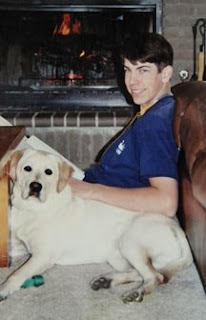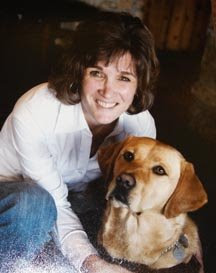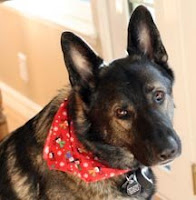Monday, July 27, 2009
Newshounds!


- Dog Fancy Magazine: After the Call of Duty. Highlighting retired service dogs, and featuring retired guide Bianca. Note: the link only gives you a teaser to the story; pick up the August 2009 issue of Dog Fancy Magazine on newsstands now to read the complete article.
- KOMO-TV News / ABC (Seattle, WA): Puppy Love for the Visually Impaired - Video. Visually impaired students at the Louis Braille School meet the next generation of Guide Dogs.
- Carbon County News (Billings, MT): Purple Paw Awarded to Stanley Northcutt at Hair Ball. A feature about alumna Chris Northcutt and her guide, Stanley.
- The Napa Valley Register (Napa County, CA): How to Host the Blind. Featuring GDB board member and alumna Vickie Kennedy and her presentation to hotel employees on how to best serve blind guests.
- Marin Independent Journal (Marin County, CA): Puppy love for 44 years; Guide Dogs volunteer helps dogs bond with humans. A profile of long-time GDB volunteer puppy socializer, Evelyn Hoffman.
- View From The Bay, KGO-TV / ABC (San Francisco, CA) - Video: Volunteers needed for Guide Dogs for the Blind. A segment talking about puppy raising volunteers.
- Good Question, KPIX-TV / CBS and CW 44 (San Francisco, CA) - Video: What Kind Of Dog Makes A Good Guide Dog? A segment featuring GDB's Puppy Socialization Coordinator, Sharon Kret.

- O Magazine: Dogs Who Can Sniff Out Cancer. Featuring GDB Master Instructor Paolo Pompanin and his career change dog, Tessy, who is involved in the cancer detection study.
- Good Question: KPIX-TV / CBS and CW 44 (San Francisco, CA) - Video: Can Dogs Detect Cancer?
A Day in the Life of… a Guide Dog in Class!

I passed all my final exams with flying colors! I know if my raiser Abby was here she would be so proud of me. I’m told that next I will go to class. I am anxious to find out exactly what that means. Over the past four months I’ve grown very close to the Canine Welfare Technicians (who take care of me), my fellow Guide Dog in training buddies, and most of all, my instructor. She has taught me so much and I know I’ll make her proud in class. Here comes a CWT now to get me. “Is it time? Is it time?” No, instead we’re going into the bathing room. Not my favorite place on campus, but I’ve learned to tolerate it. The aloe and oatmeal shampoo does leave my coat silky soft. I’m sure the CWT will also clean my teeth and ears and brush my coat. I’ve learned that it is important for me to hold very still for these rituals. I’m even comfortable having my nails clipped. Wow, have I matured!
I’m back in my kennel, and I can feel the excitement in the air. Something about today is different. This must be the day I’ve been hearing about…Dog Day. It sounds like a celebration of me and what could be better! Here comes my instructor. “Is it time? Is it time?” Yes! As I walk in perfect heel with my instructor she gives me a few words of encouragement and advice. “You’re no longer a puppy. Today you become an adult with big dog responsibilities. Everything you have learned has led you to this experience. Today you will meet the person with whom you will spend the rest of your life. This person is special and needs you to perform a very special task. We all believe in you. Remember your training and believe in yourself.” As we walk into the large building know as the dormitory I can smell many people I’ve never met before. Some of my Guide Dog buddies are here too and have already been paired with people. My instructor is leading me to the Music Room where I can only pick up one person’s scent. My person! I am so excited I can hardly contain myself. I have to sniff him up and down, give him a few licks, and really let him know how happy I am to meet him. He also seems very excited and has tears of joy in his eyes as he runs his hands along my sides in such a gentle manner. I know in this moment that we will have a very special relationship. My person, Kevin, takes the leash from my instructor and gives his first command, “heel”. I am still so excited that it is difficult to stay in heel position as we walked to our room.
We spent the rest of the day playing, cuddling, and practicing heel position. Kevin prepared and fed me my dinner before having his and then off to bed. Before I knew it we were up and starting the next day. Kevin prepared my breakfast and took me to a place called the “relieving circle”. There were eleven other of my buddies there who had been paired to people. We all motioned our quiet “good mornings” and got to business. After Kevin ate his breakfast we met in a large comfortable area called The Day Room. I got to take my mid-morning nap while the people talked about important things like crossing streets and re-working errors. After another opportunity in the relieving circle (I always use my opportunities…wouldn’t want to have an accident!) we boarded a bus and drove away from campus. I really wanted to lie down and nap more, but Kevin preferred me to sit. I could understand that we were practicing for something. The bus eventually stopped and we got off. Kevin gently slipped the harness over my head as I stood very still. He picked up the harness and commanded me forward. Although he sounded very authoritative, I knew that if it wasn’t safe I would disobey even the most confident command. My instructor had taught me the concept of “Intelligent Disobedience” well. This time there we no obstructions or hazards. I stepped forward and pulled firmly into the harness. Kevin followed hesitantly at first but eventually relaxed and walked by my hips. We flew down the sidewalk. I showed Kevin how well I knew to stop at curbs and cross the street strait as an arrow. Each time we reached an up-curb Kevin stroked my chest and gave me a kibble. I loved that I was pleasing Kevin, but I can’t lie…the kibble was the icing on the cake! What a great first walk. We reloaded the bus and drove back to campus. After lunch (Kevin’s, not mine. Drat!) we did it all over again.
That night I feel fast asleep on my fleece mat next to Kevin’s bed, and had dreams about what the rest of class would hold for us. I dreamt that I took Kevin to all my favorite places: downtown San Rafael which I know like the back of my paw, Fisherman’s Wharf where the smells never quit, and The Embarcadero where I can show off my acute awareness of the dangers of platform drop-offs. I went on to dream about being on a great stage with both Abbey and Kevin. Many people were applauding us with tears in their eyes. What a great feeling! I can’t wait to graduate and walk proudly onto that stage. I hope to see you there too!
Following the Instructors: Episode 4

Behind the Scenes at Graduation
By Joanne Ritter

Graduations at Guide Dogs for the Blind are unique celebrations – they represent the coming together of hard work, passion and commitment of so many people: puppy raisers, staff, students and supporters.
This past Saturday was a perfect day weather-wise and in so many other ways for a graduation ceremony on our California campus. In the following two videos, I’d like to take you behind the scenes so you can meet some of the people in this wonderful community.
- Video 1 (6:52 minutes): Meet some puppy raisers and new grads
- Video 2 (8:56 minutes): More raisers, grads and breeders
If you haven’t yet been to a graduation at either of our campuses (San Rafael, California or Boring, Oregon), what’s stopping you? They’re open to the public. You’ll find schedules and directions on our website, www.guidedogs.com. Bring the whole family!
Question: What did you enjoy most about your last GDB graduation?
Wednesday, July 22, 2009
The Dog Days of Summer

- The best preventative measure to prevent sun/heat exposure is to monitor your dog’s activities, and to minimize exposure during the peak hours of the day. Dogs love the warmer weather just as much as you do, but the season’s heat and sunshine can be problematic. Each summer, countless dogs are treated for heat stroke.
- While no one is safe in a parked car in the sun, dogs are especially susceptible to succumbing to heat stroke. In fact, according to AAA, a car’s interior temperature can climb to 170 degrees on an 85-degree day in less than 20 minutes, even with the windows cracked. In many states it is illegal to leave your dog in a locked car, and it’s never ok for Guide Dog puppies. GDB alumna Jen McEachen of Prince George, British Columbia, recently wrote a Letter to the Editor in her hometown warning pet owners of the dangers of leaving their pets in the car on hot days; read her letter here: www.princegeorgecitizen.com.
- Energetic games of catch or long walks/runs in high temperatures can also weaken your companion. So on super-hot days, avoid the sun by taking your dog out in the early morning or later in the evenings, instead of when the sun is highest in the sky.
- Moving water can be quite cold but in all the fun your dog may not care! Call him out periodically and check that he is not becoming excessively chilled. Trembling can be a sign of early hypothermia or just doggy excitement. Dogs whose hackles (the hair along the spine) are raised up when they exit the water are showing that they are very cold. Keep plenty of old towels on hand to dry off your dog.
- Some dogs swallow a lot of water while swimming and swell up like balloons! Keep your dog out of the water for a while if this happens and be prepared to give him plenty of opportunities to relieve himself.
- Anytime a dog swims it will expose his ears to moisture. Excessive moisture in the ear can contribute to ear infections. Care must be taken to dry and air out the dog’s ears after swimming. Check with your veterinarian if your dog is prone to ear infections before allowing him to swim.
- Ponds, sloughs, lakes, rivers: Bodies of water inhabited by wildlife may be contaminated with bacteria such as giardia; dogs should not swim in areas that would be unsuitable for humans to swim. You should also be aware of hazards such as submerged branches, fishing line etc. A gradual entry into the water is safer and less frightening to a dog than a steep bank; boat ramps and gently sloping banks are excellent entry points. Currents can be unpredictably strong; caution should be used wherever there is a flow of water. Some dogs thrill in paddling against the current but even the strongest dogs may be swept away in swift running rivers. Dog owners should be considerate of other people using the swimming area; not everyone enjoys being sprayed by wet dog shaking off!
- Ocean: All the above should be considered when taking a dog to the beach. The ocean can be overwhelming to some dogs and highly stimulating to others. Caution should be taken even wading in the ocean with small dogs and puppies. Dogs who have been in the ocean should have their coats rinsed thoroughly afterwards.
- Swimming pools: Small dogs and puppies may be more comfortable being introduced to water in a plastic kiddie pool. Keep the water very shallow at first and encourage your pup to enter by stepping into the pool yourself and using a fun toy to encourage him to follow you. Dogs should be carefully introduced to a swimming pool on leash and they should never be forced to enter the water. If your dog enters the water voluntarily he should be allowed only a few strokes before being shown how to get out of the pool. This should be repeated several times until he knows exactly where the steps are. Should your dog get into difficulties in the water, carefully guide him to the steps by the leash. If he is not on leash, you should be prepared to enter the water and take hold of his collar and guide him to the steps. Once you are certain he knows how to get out of the pool he can be turned loose to enjoy himself. In order to prevent accidents, care should be taken that your dog does not have access to the pool unattended. A pool cover is no guarantee that your dog will not enter the pool on his own, with potentially disastrous consequences. Also, keep in mind that pool chemicals can be harsh on a dog’s coat, so rinsing him off with tap water after a swim is a good idea.
- Book ASAP. Airlines allow just a few pets on board per flight, so you’ll need to book early to reserve a spot. Check safety records. If you travel with your pet in cargo, make sure that the airline has a record of few problems and deaths. The Bureau of Transportation Statistics tracks incidents by airline on a monthly basis.
- Compare fares. Fees vary by airline and how the pet travels.
- Get a clean bill of health. Most airlines require a health certificate and proof of vaccinations issued no more than 10 days before your flight.
- Pick up airline miles. Some airlines (like JetBlue and Continental) add frequent-flier miles for traveling pets to their human companion’s account.
- Look for pet-friendly hotels. There’s a dearth of pet-friendly hotels these days where your pet can stay without an extra fee. Shop around.
Puppy Raising Youth Scholarship Winners, 2009




Who's Your Soulmate?

From Mongolia to GDB

Changing Lives, One Dog at a Time

Wednesday, July 15, 2009
Embracing Change

It's no secret that all of our dogs here at GDB are pretty special. What you may not know, is that so many of the dogs that don't become guides (who we affectionately refer to as "career change" dogs) - or even many retired guides - go on to have all types of other fulfilling and rewarding careers. And even if they don't, they make for some of the best pets in the world, and still manage to touch the lives of many people.

 children) who have been involved in various criminal cases, either as victims or witnesses, who might benefit from a friendly, gentle dog's presence. In addition, he is a friend to staff members who feel the stress of the environment and subject matter they deal with every day.
children) who have been involved in various criminal cases, either as victims or witnesses, who might benefit from a friendly, gentle dog's presence. In addition, he is a friend to staff members who feel the stress of the environment and subject matter they deal with every day. 

